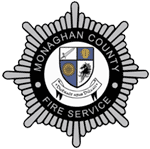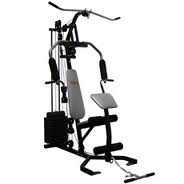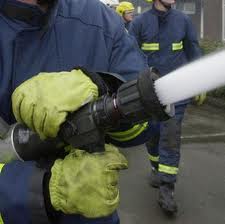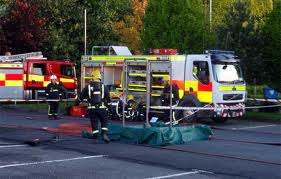 Monaghan Fire & Civil Protection is a retained fire service. Retained firefighters are an essential part of the Fire & Rescue Service. They serve rural communities in Monaghan, responding to an alerter when an emergency 112/999 call is received. A retained firefighter must live or work within five minute response of the fire station. Clearly, flexibility is key and retained fire fighters will need to be either self-employed or have an employer who is supportive and willing for the firefighter to leave work at a moments notice to attend an emergency.
Monaghan Fire & Civil Protection is a retained fire service. Retained firefighters are an essential part of the Fire & Rescue Service. They serve rural communities in Monaghan, responding to an alerter when an emergency 112/999 call is received. A retained firefighter must live or work within five minute response of the fire station. Clearly, flexibility is key and retained fire fighters will need to be either self-employed or have an employer who is supportive and willing for the firefighter to leave work at a moments notice to attend an emergency.
What is involved in becoming a FireFighter?
Firefighters are called upon to tackle a wide range of emergency situations. Incidents vary from tackling fires and rescuing people from burning buildings to dealing with chemical spillages and road traffic collisions. A sensitive approach is required when dealing with members of the public who may be distressed and confused. In addition fire fighters in Monaghan are also involved in the promotion of Fire Safety in the community through Fire Safety Week and through the Schools Safety Programme.
Is fire fighting a job for me?
Take a minute to answer the following questions honestly:
- Are you committed to promoting the safety of your community?
- Do you enjoy working as part of a team?
- Could you work under pressure to support your colleagues?
- Can you think on your feet to solve problems, react flexibly and use your initiative?
- Would you be able to deal sensitively with members of the public in difficult and emotional situations?
- Are you committed to always maintaining and developing your skills?
- Are you prepared to follow instructions from others?
- Are you prepared to work unsocial work patterns, which will include callouts at night, weekends, and public holidays?
- Are you dependable and reliable?
What skills do I require to become a fire fighter?
 To become a firefighter you need to be:
To become a firefighter you need to be:
- In good health and to have good eyesight
- You must have good physical fitness
- Must live & work within a reasonable distance of the Fire Station where you wish to serve
- You must be prepared to work at heights
- You must be prepared to work in hot and humid atmospheres
- You must be prepared to work in dark and confined spaces
- You must be prepared to work long hours at protracted incidents
Do I need to be fit to become a fire fighter?
 Fire fighters don’t need to have the fitness levels of a professional sports person but they do need to be fit. A firefighters role is extremely varied which involves working in a vast array of situations and environments. The day to day operations of a fire fighter calls upon muscular strength, endurance and flexibility at different incidents. Fitness is important to combat fatigue. The working conditions can be stressful and test not only the physical ability of firefighters, but also their mental strength so it is vitally important that firefighters are fit for duty to best tackle the challenges that face them.
Fire fighters don’t need to have the fitness levels of a professional sports person but they do need to be fit. A firefighters role is extremely varied which involves working in a vast array of situations and environments. The day to day operations of a fire fighter calls upon muscular strength, endurance and flexibility at different incidents. Fitness is important to combat fatigue. The working conditions can be stressful and test not only the physical ability of firefighters, but also their mental strength so it is vitally important that firefighters are fit for duty to best tackle the challenges that face them.
What is involved in the recruitment process involve?
Interview stage: At the interview you will be asked questions relating to your knowledge, skills and attributes to determine your suitability for the role of a Firefighter. Ensure you are well prepared, have done research into the Fire Service and the post you hope to fill, turn up on time and in a presentable manner.
Reference: References will only be sent for if you are successful at interview, prior to your medical. All applicants will need to supply personal referees and details of your current or previous employer for references to be obtained
Medical: You will be asked to attend a medical where you will be examined by the Fire Service Doctor. You will be asked to complete a questionnaire covering your medical history and will then be subject to a series of tests including:
- Hearing test – you will sit in a sound proof booth wearing headphones and will be asked to press a button when you hear a sound.
- Step test – you will be asked to step up and down on a box while your heart rate is monitored and the rate of step is gradually increased.
- Lung function – you will be asked to blow hard and long down a hollow tube until all your lung capacity is fully exhaled – a reading is taken and assessed accordingly.
- Physical stamina – you will be asked to squat on a machine designed to test your back and thigh strength and then pull a specified measurement.
What training is involved to become a Fire-fighter?
 Training is an ongoing process throughout your career as a retained firefighter. Initial training is usually carried out in the training school facilities based in Dundalk and Sligo. Initial training is carried out in two parts each lasting two weeks in duration i.e. recruits training and breathing apparatus training. Failure to successfully complete either course results in dismissal from the service.
Training is an ongoing process throughout your career as a retained firefighter. Initial training is usually carried out in the training school facilities based in Dundalk and Sligo. Initial training is carried out in two parts each lasting two weeks in duration i.e. recruits training and breathing apparatus training. Failure to successfully complete either course results in dismissal from the service.
- Recruits training: Here you’ll be taught basic firefighting skills like ladder safety, hose laying, use of road traffic equipment, basic HAZMAT awareness, fire safety and the use of fire extinguishers etc.
- Breathing Apparatus training: This includes training on the elementary physiology of respiration, safe working practices, equipment use and maintenance, set duration, operational testing to enable a firefighter to safely enter a building on fire, use of guidelines, distress signal and entry control procedures.
What other training do Fire fighters receive?
 Training is a continuous process within the fire service. After the initial recruits and breathing apparatus training firefighters will continue to develop themselves through training at station level on drill nights and through official specialised training such as;
Training is a continuous process within the fire service. After the initial recruits and breathing apparatus training firefighters will continue to develop themselves through training at station level on drill nights and through official specialised training such as;
- Compartmental Fire Behaviour Training: This is a 3 day course based in Dundalk. This training helps firefighters understand the concept of backdraught and flashover. It provides training on the door entry procedures, branch techniques & flow rates, development of a fire, tactics that should be deployed and indicators of potential explosive atmospheres within a compartment fire
- HAZMAT Training: Hazardous materials incidents are increasingly complex and challenging. HAZMAT training provides fire-fighters usually at sub officer level and up information on best operational procedures on dealing with hazardous substance. Fire-fighters learn about the different classes of substance, information retrieval and how to deal with HAZMAT incidents. This is a two week course that is usually carried out in Co. Cork.
- Pump operators course: This is continuing on from training received at recruit and station level. Fire fighters will receive information on equipment, extraction techniques, casualty management and planning and staging exercises.
- Fire Prevention for Junior Officers: Training is given on the basic elements of fire prevention and fire protection measures that are adopted by local authorities in Ireland.
- Pump Operators Course: Firefighters receive training on the pumping capabilities of appliances and portable pumps. It also trains fire fighters to trouble shoot in the event of problems at an incident where water supply is an issue.
- Officer training: From Sub-officer to Senior Officer training is provided on leadership, command and officership in the fire service.
What type of incidents do fire fighters respond to?
Fire fighters in Monaghan response to a wide range of emergencies such as;
- Fires – House, Forest, Gorse.
- Road traffic collisions
- Industrial accidents.
- Chemical Incidents.
- Oil spillage.
- Flooding and other weather related incidents
